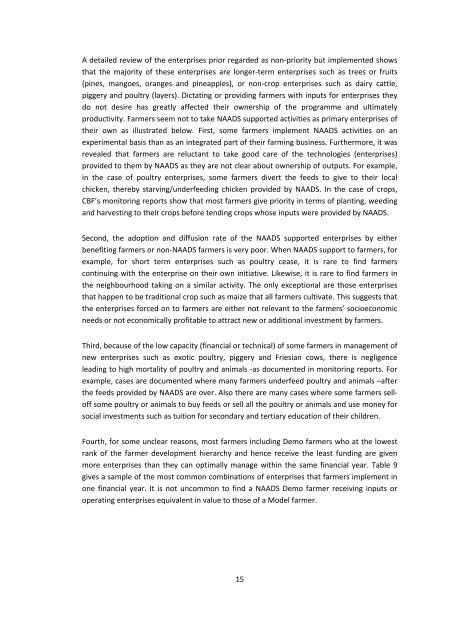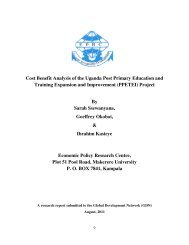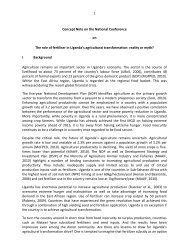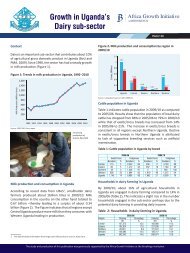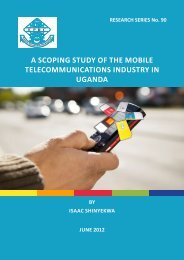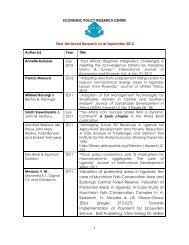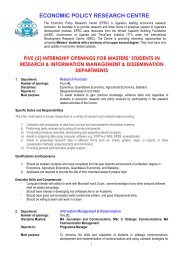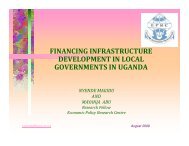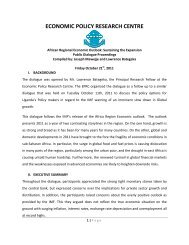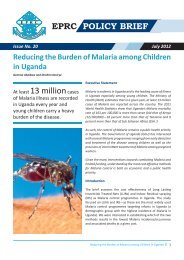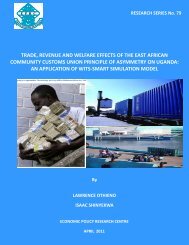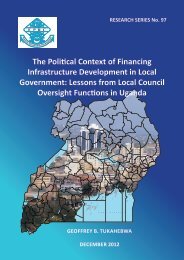the case of iganga district - Economic Policy Research Centre
the case of iganga district - Economic Policy Research Centre
the case of iganga district - Economic Policy Research Centre
- No tags were found...
Create successful ePaper yourself
Turn your PDF publications into a flip-book with our unique Google optimized e-Paper software.
A detailed review <strong>of</strong> <strong>the</strong> enterprises prior regarded as non‐priority but implemented showsthat <strong>the</strong> majority <strong>of</strong> <strong>the</strong>se enterprises are longer‐term enterprises such as trees or fruits(pines, mangoes, oranges and pineapples), or non‐crop enterprises such as dairy cattle,piggery and poultry (layers). Dictating or providing farmers with inputs for enterprises <strong>the</strong>ydo not desire has greatly affected <strong>the</strong>ir ownership <strong>of</strong> <strong>the</strong> programme and ultimatelyproductivity. Farmers seem not to take NAADS supported activities as primary enterprises <strong>of</strong><strong>the</strong>ir own as illustrated below. First, some farmers implement NAADS activities on anexperimental basis than as an integrated part <strong>of</strong> <strong>the</strong>ir farming business. Fur<strong>the</strong>rmore, it wasrevealed that farmers are reluctant to take good care <strong>of</strong> <strong>the</strong> technologies (enterprises)provided to <strong>the</strong>m by NAADS as <strong>the</strong>y are not clear about ownership <strong>of</strong> outputs. For example,in <strong>the</strong> <strong>case</strong> <strong>of</strong> poultry enterprises, some farmers divert <strong>the</strong> feeds to give to <strong>the</strong>ir localchicken, <strong>the</strong>reby starving/underfeeding chicken provided by NAADS. In <strong>the</strong> <strong>case</strong> <strong>of</strong> crops,CBF’s monitoring reports show that most farmers give priority in terms <strong>of</strong> planting, weedingand harvesting to <strong>the</strong>ir crops before tending crops whose inputs were provided by NAADS.Second, <strong>the</strong> adoption and diffusion rate <strong>of</strong> <strong>the</strong> NAADS supported enterprises by ei<strong>the</strong>rbenefiting farmers or non‐NAADS farmers is very poor. When NAADS support to farmers, forexample, for short term enterprises such as poultry cease, it is rare to find farmerscontinuing with <strong>the</strong> enterprise on <strong>the</strong>ir own initiative. Likewise, it is rare to find farmers in<strong>the</strong> neighbourhood taking on a similar activity. The only exceptional are those enterprisesthat happen to be traditional crop such as maize that all farmers cultivate. This suggests that<strong>the</strong> enterprises forced on to farmers are ei<strong>the</strong>r not relevant to <strong>the</strong> farmers’ socioeconomicneeds or not economically pr<strong>of</strong>itable to attract new or additional investment by farmers.Third, because <strong>of</strong> <strong>the</strong> low capacity (financial or technical) <strong>of</strong> some farmers in management <strong>of</strong>new enterprises such as exotic poultry, piggery and Friesian cows, <strong>the</strong>re is negligenceleading to high mortality <strong>of</strong> poultry and animals ‐as documented in monitoring reports. Forexample, <strong>case</strong>s are documented where many farmers underfeed poultry and animals –after<strong>the</strong> feeds provided by NAADS are over. Also <strong>the</strong>re are many <strong>case</strong>s where some farmers sell<strong>of</strong>fsome poultry or animals to buy feeds or sell all <strong>the</strong> poultry or animals and use money forsocial investments such as tuition for secondary and tertiary education <strong>of</strong> <strong>the</strong>ir children.Fourth, for some unclear reasons, most farmers including Demo farmers who at <strong>the</strong> lowestrank <strong>of</strong> <strong>the</strong> farmer development hierarchy and hence receive <strong>the</strong> least funding are givenmore enterprises than <strong>the</strong>y can optimally manage within <strong>the</strong> same financial year. Table 9gives a sample <strong>of</strong> <strong>the</strong> most common combinations <strong>of</strong> enterprises that farmers implement inone financial year. It is not uncommon to find a NAADS Demo farmer receiving inputs oroperating enterprises equivalent in value to those <strong>of</strong> a Model farmer.15


